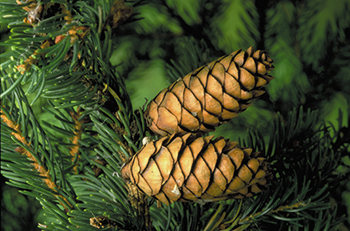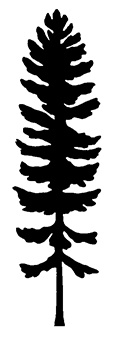Nova Scotia's provincial symbols
One of Canada’s three Atlantic Provinces, Nova Scotia is located almost exactly halfway between the Equator and the North Pole. It is the second-smallest province in Canada.
Origin of the name
Nova Scotia was named by Sir William Alexander, who received a grant to all the land between New England and Newfoundland from King James VI of Scotland (King James I of England) in 1621. The official charter was in Latin and the name "New Scotland" retained its Latin form — Nova Scotia.
Population (2006): 934,400
Area: Land – 52,840 km2Fresh water – 2,650 km2Total – 55,490 km2Capital: HalifaxDate of entry into Confederation: July 1, 1867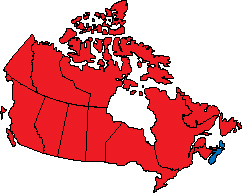
History
The Mi’kmaq of the Algonquian linguistic group inhabited Nova Scotia long before the arrival of European explorers. They were among the first of Canada’s Aboriginal peoples to see Europeans. The Mi’kmaq allied themselves with the French throughout early Canadian history, helping them adjust to the land and fight the British.
All of Nova Scotia – as well as parts of Quebec, New Brunswick and Maine – was originally known as Acadia and mainly settled by the French. Fur trader Pierre Du Gua de Monts established the first successful agricultural settlement in Canada at Port-Royal (now Annapolis Royal, Nova Scotia) in 1605. For the next century, the British and the French fought over the area. Control passed back and forth until 1713, when all of Acadia, except Île Royale (now Cape Breton Island), was ceded to the British under the Treaty of Utrecht.
After the Seven Years’ War, Nova Scotia included St. John’s Island (as Prince Edward Island was then known), Cape Breton Island and the area now known as New Brunswick. In 1769, St. John’s Island separated from Nova Scotia. In 1784, after a great influx of loyalist refugees from the United States, Nova Scotia was divided to create the colonies of New Brunswick and Cape Breton Island. However, Cape Breton again became part of Nova Scotia in 1820.
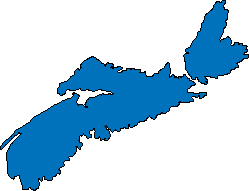
Coat of arms
Nova Scotia's coat of arms, granted by King Charles I in 1625, is the oldest of any province or territory. The shield features the Cross of St. Andrew. To differentiate between Scotland and Nova Scotia, the colours of the cross are reversed: blue on white. At the centre of the Nova Scotia shield is the shield of the Royal Arms of Scotland, containing a royal lion within a double red border on a field of yellow or gold.
The crest above the shield features two hands, one armed and the other bare, supporting a laurel and a thistle. One interpretation of this has the armed hand and the thistle representing the vow of the King of the Scots to protect his subjects, and the bare hand and the laurel sprig representing the conquest of hardships to be met in Nova Scotia. The laurel sprig is a symbol of peace, triumph and conquest.
The shield is supported by a crowned unicorn, part of Scotland’s royal coat of arms, and an Aboriginal man, representing the province’s native Indian population. A royal helmet — facing forward — rests on the shield. A unique feature of the Nova Scotia coat of arms is that the motto is placed above the arms, a common practice in Scotland.
Nova Scotia is the only province to have had a coat of arms annulled. When the province joined Confederation, it was assigned a new coat of arms, as were the other new provinces. Unlike the other provinces, however, Nova Scotia had already been granted one. After the First World War, there was a movement to restore the original arms. This change received royal warrant from King George V in 1929.
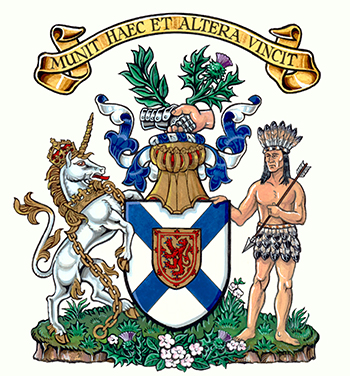
Motto
Munit haec et altera vincit (One defends and the other conquers)
Flag
After receiving royal warrant from King George V in 1929, the flag of Nova Scotia was the first flag in the overseas Commonwealth to be authorized by royal charter.
Derived from the ancient arms granted in 1625, the flag features the province’s shield extended in a rectangular shape. The width of the flag is twice its height.
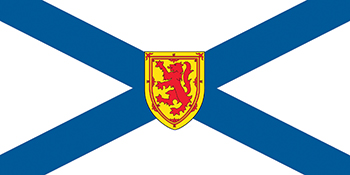
Floral emblem
In Nova Scotia, the trailing arbutus or mayflower (Epigaea repens L) was officially adopted in 1901, when an act of the legislature stated it “is hereby declared to be and from time immemorial to have been the emblem of Nova Scotia.”
The mayflower derives its name from the Massachusetts pilgrims, who saw it as the first flower of spring and named it after the ship that brought them to Plymouth Rock. As far back as 1825, the mayflower was used as a decorative motif on the front page of the Nova Scotian. During the 19th century, it appeared on the buttons of the Nova Scotia militia and on postage stamps along with the rose, thistle and shamrock.
Blooming in the forest glades of early spring – often amid the last remaining snow of winter – the mayflower’s pink flowers are delicately scented, growing on stems from 15 to 30 centimetres long.
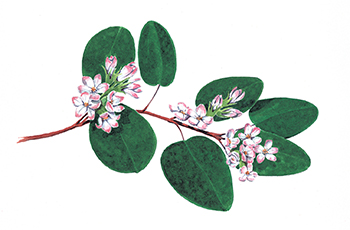
Other provincial symbols
Animal
A purely Canadian breed, the Nova Scotia duck tolling retriever dog is the smallest of all retrievers. Bred in Nova Scotia for more than a hundred years, it was given its Canadian Kennel Club designation as an official breed in 1945 and was declared the provincial dog in 1995.
Known for its intelligence, endurance and for being an excellent pet, the Nova Scotia duck tolling retriever tolls – or lures – the game, rather than retrieving it. It entices waterfowl to get within range of the hunter in his blind.

Bird
Nova Scotia adopted the osprey (Pandion haliaetus) as its official bird by an Act of the House of Assembly in 1994.
This bird of prey is larger than a hawk and smaller than an eagle. Its main source of food is fish, and it can often be seen flying over oceans, rivers and lakes. Ospreys migrate south in the winter. Older birds return north to mate, while younger birds stay south until they mature.
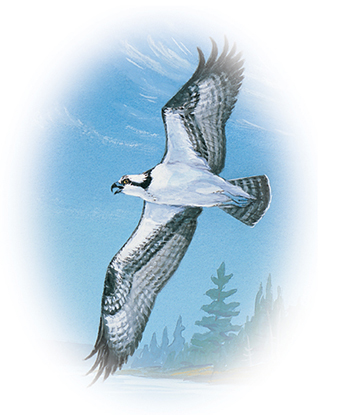
Fruit
Native to Nova Scotia and popular throughout its history, the wild blueberry was declared the provincial berry in 1996.
Originally found in the wild and picked by hand, this fruit is now widely cultivated and many fields are harvested with machines. Over the past 50 years, the wild blueberry industry has grown from the local market to become a significant frozen food export business. Nova Scotia’s wild blueberries are sold in over 20 countries around the world, and the industry makes a substantial contribution to the economy. The province is one of five regions in Canada where wild blueberries can be grown and is the largest producer in the country.
Gemstone
Declared the provincial gemstone of Nova Scotia in 1999, agate is a variegated and banded form of quartz with a beautiful translucency. It is used for jewellery and for viewing as a collectible. White and grey are common colours for agate, but blue and other colours may be found. Moss and banded agate are very delicate and beautiful.
All of the varied forms of agate are common in the dark-coloured basalt flows of Jurassic age. These basalts form the spectacular hills around the Bay of Fundy and represent rock units deposited during the time of dinosaurs in Nova Scotia. Agate is the birthstone for May, the month in which Nova Scotia’s provincial flower, the mayflower, first blooms.
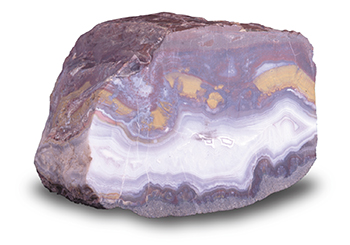
Horse
Declared the provincial horse of Nova Scotia in 2008, the Sable Island horse symbolizes the will to survive in a harsh environment.
Among the few wild horse populations left in the world, the origins of the Sable Island horse is not known. However, scientists believe they may be distantly related to Icelandic horses. In 1960, when the Canadian government announced that the horses would be removed from the island and auctioned off or slaughtered for dog food, a public outcry ensued. Schoolchildren across Canada wrote to Prime Minister John Diefenbaker, pleading with him to stop the cull. Today, the horses of Sable Island are a national treasure because their legend is linked to the settlement of Nova Scotia and Canada.
Mineral
A mineral from the zeolite group, stilbite is widely noted for its beautiful crystals, pleasing colours, and relative abundance. Declared the provincial mineral of Nova Scotia in 1999, stillbite is abundant in the Jurassic-aged basalt flows located along the Bay of Fundy and Minas Basin.
Stillbite’s distinguishing feature is its beautiful, wheat-sheaf structures in white, grey, yellow, or brownish-red. An excellent natural filter because of its structure and chemically sticky surfaces, stillbite has many diverse uses from water softeners and filter components to molecular sponges.
Tartan
The Nova Scotia Tartan was the first provincial tartan in Canada, and was made an official symbol in 1963. Designed by Mrs. Bessie Murray, it was registered in the books of the Court of the Lord Lyon (the heraldic authority for Scotland) in 1956. Represented in the design are the blue of sea and sky; the dark and light greens of evergreens and deciduous trees characteristic of the province; the white of rocks and coastline surf; the gold of Nova Scotia's Royal Charter; and the red symbolizing the lion rampant on the Nova Scotia crest.
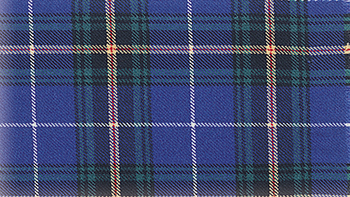
Tree
Nova Scotia adopted the red spruce (Picea rubens) as its official tree by an Act of the House of Assembly in 1988. The tree is able to survive in virtually any terrain and condition, and was chosen to represent the strength and resilience of Nova Scotians.
